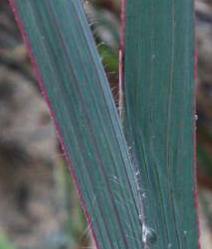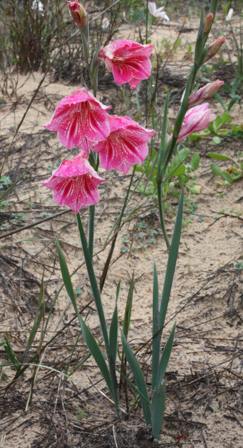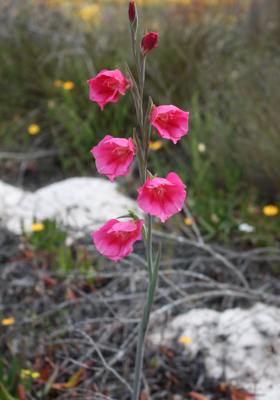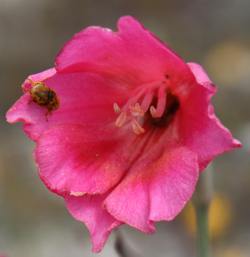Gladiolus caryophyllaceus
Gladiolus caryophyllaceus (Burm.f.) Poir.
Family: Iridaceae
Common names: Pink Afrikander (Eng.); Pienkafrikaner, Sandveldlelie, Sandpypie (Afr.)
Introduction
Gladiolus caryophyllaceus is a robust and beautiful pink-flowered cormous plant with a heady perfume reminiscent of cloves and carnations. It makes a fine cut flower and subject for raised beds but is short-lived in cultivation in South Africa, yet ironically has become an aggressive invader in Western Australia.

Description
Description
This winter-growing, summer-dormant geophyte reaches up to 0.9 m high in full flower. It has a deep-seated, globose corm surrounded by several fibrous outer tunics and 4-5 erect, greenish-grey, lance-shaped leaves which are sometimes hairy and spirally twisted, with prominent veins and reddish margins.

The flower stem is sparsely covered in short, soft hairs and bears 2-10 large funnel-shaped blooms with long, curved perianth tubes. The light to deep pink, mauve or reddish tepals usually have a prominent deep pink linear marking and occasionally numerous pink spots in the lower three tepals. The ripe fruit is an elongate dry capsule, which splits longitudinally, liberating numerous aerodynamic, winged papery seeds. Flowering takes place from late August to late October.

Conservation Status
Status
Gladiolus caryophyllaceus has a conservation status of Least Concern (LC). This indicates that it does not qualify for any of the threat categories listed by the International Union for Conservation of Nature (IUCN). Historically, lowland subpopulations near Atlantis and Hopefield on the Cape West Coast were almost decimated by excessive picking, and are currently threatened by invasive alien plants, agricultural expansion and urbanisation. However, as a whole the species is not likely to become extinct due to its wide distribution, which in certain parts includes relatively inaccessible mountainous terrain. In recent years, an additional threat to lowland subpopulations near Atlantis has been a marked increase in numbers of Cape mole rats, which consume the corms (Thys Greeff, personal communication).

Distribution and habitat
Distribution description
Gladiolus caryophyllaceus is widespread in the Fynbos Biome in the Western Cape and also occurs in the Succulent Karoo Biome in the northwestern part of the Northern Cape. Its distribution extends from Komaggas in western Namaqualand to Caledon in the southern Cape, and inland to Nieuwoudtville on the Bokkeveld Escarpment and the Swartberg Mountains in the Little Karoo. Despite its wide distribution, it isn't very common anywhere and typically the plants occur singly or in isolated small groups. Its habitat is varied, occurring on coastal granite ridges in western Namaqualand, in sandstone in hilly and mountainous terrain near Nieuwoudtville on the Bokkeveld Escarpment, and on lowland flats near Atlantis, Darling, Hopefield and Aurora it frequents deep, fast-draining sands, often occurring amongst restios. It used to be abundant in the Clanwilliam district and is often exhibited at the annual wildflower show there.
In the absence of its natural pathogens, G. caryophyllaceus has become an aggressive invader in the southwestern part of Western Australia. There it occurs in dense colonies numbering tens of thousands of plants in urban remnant native bushland in the vicinity of Perth, including Kings Park and Botanic Garden within the city, and stretching from Cataby north of Perth to Lake Grace to the southeast of this city. Known there as 'Pink Gladdies', it favours disturbed, nutrient-poor sandy sites and out-competes the local flora. The species no doubt escaped from cultivation in seed form and easily naturalised in the Mediterranean climate of southwestern Australia, where the plant has been established for more than 60 years.
The genus Gladiolus has about 250 species and is native to tropical and southern Africa, Madagascar, the Middle East, Mediterranean Europe and Asia Minor. Its major centre of diversity is in the southwestern Cape, in the geographical epicentre of the winter rainfall zone, which contains a very high number of endemic species.
Derivation of name and historical aspects
History
The generic name Gladiolus is derived from the Latin gladiolus, meaning 'little sword', which is descriptive of the sword-like leaves which most species have. Gladiolus caryophyllaceus has been known since 1685 when the German natural history artist Hendrik Claudius illustrated it in watercolour while accompanying Simon van der Stel on his journey to Namaqualand. In 1932, nearly two and a half centuries later, the painting appeared in print for the first time, in reduced size in monochrome, in a publication edited by Gilbert Waterhouse, detailing Simon van der Stel's journal of his expedition to Namaqualand from 1685-1686. Almost half a century after that, in 1979, the painting was finally published in colour in a life size rendition of the journal. The plant was initially described as Antholyza caryophyllacea by the Dutch botanist Nicolaas Laurens Burmann [1734-1793] in the first volume of the Prodromus Flora Capensis in 1768 and subsequently transferred to Gladiolus by the French botanist, clergyman and explorer, Jean Poiret, in 1811.
The specific name caryophyllaceus is descriptive of the flower colour, which is not unlike that of the Mediterranean herbaceous perennial Dianthus caryophyllus (family Caryophyllaceae) , from which the florist's carnation was bred and whose scent, fortuitously, has a close affinity with that of G. caryophyllaceus.
Gladiolus and Freesia are South Africa's most important geophytes in world horticulture, especially the bold, summer-flowering Gladiolus hybrids which are widely grown as bedding plants and for their long-lasting cut flowers. By the 1820s, breeding of Cape Gladiolus species had begun in England, which resulted in the spring-flowering Colvillei-nanus hybrids, from crosses between G. cardinalis , G. carneus and G. tristis. Following the later introduction of the more robust summer-flowering G. dalenii and G. oppositiflorus , and crosses between these and a few other summer-growing species, the 'grandiflora' hybrids arose, from which the modern summer-flowering strains of today originated. These achievements attest to the plant breeders' skills, using only a few species.
Ecology
Ecology
Gladiolus caryophyllaceus corms commence active growth in autumn, grow rapidly through the winter months, flower in spring and are dormant for the duration of summer. Each corm is replaced annually by a new corm, which develops above the old one during the growing period. At the beginning of summer, the ripe, aerodynamic seeds are shed from dry capsules by the shaking action of wind, landing some distance away from the mother plants. During the dry summer months, the dormant seeds become covered with wind-blown sand and germinate following the first autumn rains.
In the wild, mole rats and porcupines consume the corms of G. caryophyllaceus. The corms evade predation to a limited extent by being deep-seated and growing within the protection of restio clumps in sandy soils on lowland flats, and by growing on stony slopes in mountainous areas. However, the species relies mainly on prolific seed production to ensure its survival, sometimes producing more than four hundred seeds per plant. In habitat the leaves are sometimes grazed by antelope and the seed capsules are often heavily parasitised by insect larvae.
It is not precisely known what pollinates G. caryophyllaceus but long-tongued bees may be the pollinators. I have noticed small brown monkey beetles visiting the flowers near Atlantis but these play no role in pollination as they do not come into contact with the anthers and stigma.

Uses
Use
Historically the corms of Gladiolus caryophyllaceus are known to have been eaten by the indigenous Nama people in Namaqualand. In ornamental horticulture, this species is used to a limited extent by specialist bulb growers as a container plant or subject for raised beds.
Growing Gladiolus caryophyllaceus
Grow
The plants usually have a short lifespan of about five or six years in cultivation in South Africa, as their corms are highly susceptible to fungal pathogens. Typically, they grow strongly for the first few years from seed, flower for two or three seasons, then succumb to fungal disease.
In temperate climates where winter temperatures do not drop below freezing, they are best grown in deep, raised beds in a position receiving bright light for as much of the day as possible. In cold climates they have to be grown in containers in a well-ventilated environment, in a cool greenhouse. Plant the corms 3 cm deep in autumn in a sharply drained, gritty medium such as three parts coarse river sand and one part finely milled bark or potting compost. Water the plants heavily after planting but not again until the leaf shoots appear, then water heavily once per week during the winter growing period. Do not keep the soil constantly moist but allow it to dry out slightly before the next watering. During the summer dormant period, keep the corms as dry as possible.
Gladiolus caryophyllaceus is self-sterile and readily sets seed following hand-pollination amongst flowers of genetically different individuals. It rarely multiplies by corm offsets and is best propagated from seed. Sow the seeds in autumn in the same medium recommended for adult corms and keep moist by watering with a fine rose-cap. Fresh seeds germinate readily within four to five weeks and seedlings usually flower for the first time in their third season, in ideal conditions.
In susceptible areas, dust the corms with a contact fungicide prior to planting, as the corms are highly susceptible to infection by parasitic fungi including Botrytis and Fusarium during conditions of excess humidity in summer. The corms and leaf bases are subject to mealy bug infestation, especially in late autumn and early winter, for which a systemic insecticide can be used.
In situ conservation: The remaining threatened lowland subpopulations of Gladiolus caryophyllaceus near Atlantis and Hopefield occur on privately owned farmland and it is to be highly commended that they are being conserved and monitored by landowners Rosh Sewpersad and Tony Martin in the Atlantis district and by Philbert Melck in the Hopefield district.
Ex situ conservation: Lowland forms of Gladiolus caryophyllaceus are being cultivated and propagated at Kirstenbosch National Botanical Garden for display in the Botanical Society Conservatory, and may be used in restoration programmes in future. Seeds of lowland forms have been collected in the wild and are in long-term cold storage in the Millenium Seed Bank at Wakehurst Place, UK.
References
- Barnard, T.T. 1972. On hybrids and hybridization. In G.J. Lewis & A.A. Obermeyer, Gladiolus , a revision of the South African species . Journal of South African Botany, Supplementary vol. 10 . Purnell, Cape Town.
- Duncan, G.D. 2010. Grow bulbs . Kirstenbosch Gardening Series. South African National Biodiversity Institute, Cape Town.
- Duncan, G.D. 2012. Geophyte research and production in South Africa. In R. Kamenetsky & H. Okubo, Ornamental geophytes: from basic science to sustainable horticultural production : 485-503. CRC Press, Boca Raton.
- Du Plessis, N.M. & Duncan, G.D. 1989. Bulbous plants of southern Africa . Tafelberg, Cape Town.
- Goldblatt, P. & Manning, J. 1998. Gladiolus in southern Africa . Fernwood Press, Vlaeberg.
- Hussey, B.M.J., Keighery, G.J., Dodd, J., Lloyd, S.G., & Cousens, R.D. 1997. Western Weeds : a guide to the weeds of Western Australia . Plant Protection Society of Western Australia, Perth.
- Jeppe, B.J. & Duncan, G.D. 1989. Spring and winter flowering bulbs of the Cape . Oxford University Press, Cape Town.
- Marchant, N.G., Wheeler, J.R., Rye, B.L., Bennett, E.M., Lander, N.S., & MacFarlane, T.D. 1987. Flora of the Perth Region . Western Australian Herbarium, Perth.
- Mucina, L. & Rutherford, M.C. 2006. The vegetation of South Africa, Lesotho and Swaziland. Strelitzia 19 . South African National Biodiversity Institute, Pretoria.
- Rourke, J.P. 1985. From threatened species to invasive weed: the strange case of Gladiolus caryophyllaceus . Veld & Flora 71: 126.
- Victor, J.E. 2011. Gladiolus caryophyllaceus (Burm.f.) Poir. National Assessment Red List of South African Plants version 2013.1. Accessed on 2013/08/16.
- Waterhouse, G. 1932. Simon van der Stel's journal of his expedition to Namaqualand 1685/6 . Hodges, Figgis & Co., Dublin.
- Waterhouse, G., De Wet, G.C. & Pheiffer, R.H. 1979. Simon van der Stel's journey to Namaqualand in 1685 . Human & Rousseau, Cape Town and Pretoria.
Credits
Graham Duncan
Kirstenbosch National Botanical Garden
October 2013
Plant Attributes:
Plant Type: Bulb
SA Distribution: Northern Cape, Western Cape
Soil type: Sandy, Loam
Flowering season: Spring, Early Summer
PH: Acid
Flower colour: Pink
Aspect: Full Sun, Morning Sun (Semi Shade)
Gardening skill: Challenging
Special Features:
Horticultural zones








Rate this article
Article well written and informative
Rate this plant
Is this an interesting plant?
Login to add your Comment
Back to topNot registered yet? Click here to register.